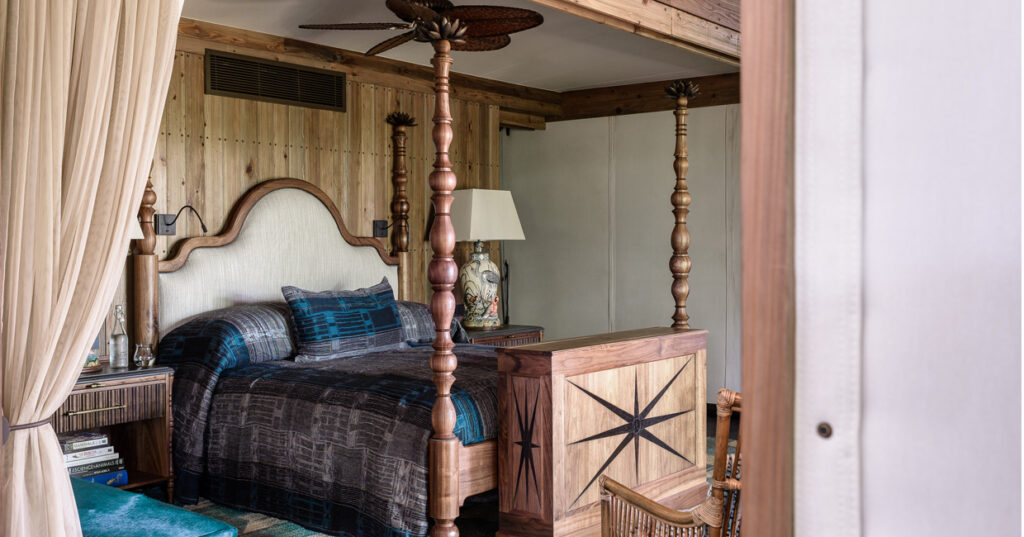The Tollman family has channelled decades of industry experience and their lifelong passion for the African bush into reimagining this exceptional safari lodge on the Moremi Game Reserve …
Named for the pied kingfisher which makes its home amid Moremi Game Reserve’s abundant waterways, Xigera Safari Lodge melds seamlessly with the lush landscape of the Okavango Delta. This remarkable World Heritage Site in northwest Botswana offers vast swathes of seasonal floodplains, forests and grasslands in which a wealth of species thrive.
Xigera Safari Lodge is the legacy project of the Tollman family, whose love affair with the African bush spans a lifetime. As custodians of the lodge, they feel their responsibility to preserve and protect the land keenly. Running the property almost entirely on solar power, installing a photovoltaic farm to charge electric game-drive vehicles, an on-site composter, and a thermodynamic geyser for the supply of hot water are just some of the measures introduced to reduce the property’s environmental footprint.
The sincerity of the family’s passion for Africa’s people, its scenery and breathtaking wildlife, also manifests in the integrity of the lodge’s interiors. Toni Tollman, Red Carnation’s director of design and projects; architectural designer, Philip Fourie; and architect, Anton de Kock, worked in collaboration with Southern Guild to create a truly original and authentic design.
The framing element of their interior concept is an extensive collaboration with local artists and craftsmen. Indeed, close to 90% of the furniture and furnishings have been commissioned from more than 80 talented creatives, including David Krynauw, Madoda Fani, Andile Dyalvane, Cheick Diallo, Zizipho Poswa, Gregor Jenkin, Laurie Wiid van Heerden, and many more.
From Porky Hefer’s human-sized woven nests on the decks for guests to nestle in, to a remarkable sleep-out in a three-storey stell baobab tree 1km from camp – and from a totemic firepit sculpture by blacksmith artist Conrad Hicks, to a fireplace formed from hand-beaten copper in the form of a lily, these commissioned pieces are rich with narrative and local significance.
The experience begins as guests arrive by light aircraft either from Maun or Ksana, reaching the lodge by road or boat via an elevated bridge. Cocooned amidst a canopy of magnificent trees, the lodge’s structures are entirely concealed by the bush, with breathtaking views over the floodplains.
Architect Anton de Kock’s design was inspired by a sighting of a fishing owl in flight on his first site visit. Each of the lodge’s 12 suites float on raised stilts above the water, entirely unobtrusive to the wildlife passing underneath. The impressive two-bedroom family suite is located on two islands, bridged by an extraordinary bronze lily centrepiece designed by Anton and created by sculptor, Otto du Plessis.
Each air-conditioned suite offers 184m2 of indoor and outdoor living space, incorporating a bedroom, spacious bathroom, separate living and dressing areas and peaceful outdoor decks with gazebos and daybeds.
Inside these individually designed private havens, the commissioned furniture and furnishings create a multi-layered and textural aesthetic. The Fan Palm Suite, for example, is awash with earth tones, from burnt red to walnut and biscuit-coloured clay. Ceramic bedside lamps by Ardmore depict some of the local flora and fauna, brought to life using the suite’s colour palette.
The lounge carpet was woven by Coral & Hive – an all-women, ethically operated company – making use of Karakul wool, from sheep that are raised in the Karoo, in South Africa.
The Knobthorn Suite pays homage to the Okavanga Delta’s evergreen forests, with its spring-green custom Kassena Server by Dokter and Misses. The Johannesburg-based brand drew inspiration from the patterned adobe structures built by the Kassena people, who live in the Tiébélé region on the border of Ghana and Burkina Faso.
In the bedroom, an ebonised walnut and bronze bed by Duchenne cabinetry, in partnership with Southern Guild, melds African totem references with traditional timbercraft. Toni Tollman selected the headboard fabrics from some of Europe’s finest fabric houses.
The Sausage Tree Suite is particularly vibrant, its eye-catching ruby-red textiles capturing the beauty of the tree’s maroon-coloured blooms. Some of its finest features include a one-of-a-kind heartwood bowl by Port Alfred, ceramic stools by Atang Tshikare, and an Igubu bath pedestal by Chuma Maweni.
The ebonised eucalyptus side table by Cape Town-based sculptor and arborist, Adam Birch, is a perfect example of the dedication and scale involved in the project. Adam spent seven months living and working on-site, carving over 150 large-scale timber sculptures for the lodge’s interior and outdoor spaces. Not only this, but he worked alongside a team of locals, equipping them with woodworking skills that will be theirs for life.
Aside from the suites, guests can make use of Xigera Safari Lodge’s tranquil spa. In a shift from the physical forms of nature that inspire the lodge’s interiors (such as the baobab and lily) the spa draws from the cycles of nature – the seasons, life and death, rebirth, light and dark.
Two treatment rooms sit side by side – one offering couple’s treatments, the other a single treatment bed and manipedi chair. Guests can decide if they’d prefer the room enclosed, with air conditioning, or opened up to the wonderful views.
Xigera’s wellness pavilion, meanwhile, encompasses a relaxing reception area, as well as a yoga deck used for for sunrise and sunset yoga and meditation, and a state-of-the-art Technogym-appointed fitness centre. A swimming pool overlooks the river and deck, allowing guests to soak up their unique surrounds.
For an entirely different experience altogether, guests can sleep beneath the stars at The Baobab Treehouse. Set 1km from the lodge, with its own guide stationed nearby, this remarkable steel sculpture emerges from the croton trees, nearly 10m above the floodplain. Its design was sparked by Jacobus Hendrick’s acclaimed painting of a solitary baobab tree.
Atop a winding staircase, guests will find a spacious bathroom on the first level, and a beautifully-appointed bedroom with carved timber furniture on the second. Guests can open the bedroom’s canvas walls for a truly immersive experience.



